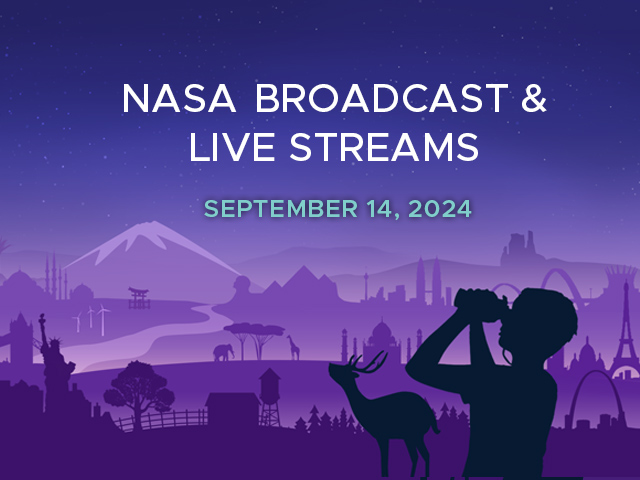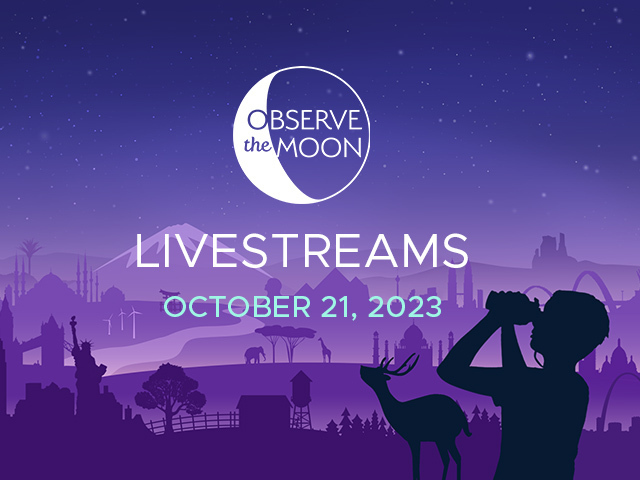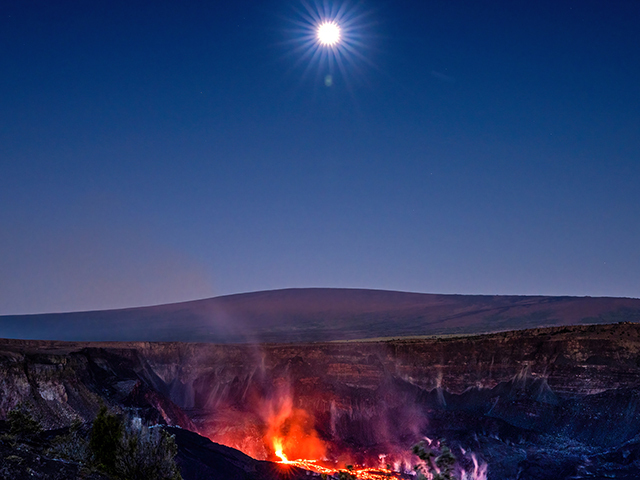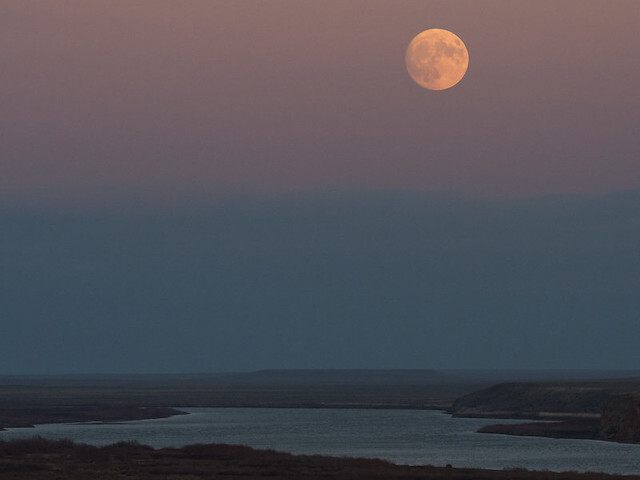News | May 7, 2017
The Next Full Moon is the Flower Moon, Corn Planting Moon, or the Milk Moon

The next full Moon will be on Wednesday afternoon, May 10, 2017, appearing "opposite" the Sun (in Earth-based longitude) at 5:43 PM EDT. The Moon will appear full for about three days around this time, from Tuesday morning through Friday morning.
The Maine Farmer's Almanac first published "Indian names" for the full Moons in the 1930's. According to this almanac, as the second full Moon of spring the Native American tribes of what is now the northern and eastern United States named this the Flower Moon, as flowers are abundant this time of year in most of these areas. Other names include the Corn Planting Moon or the Milk Moon.
In lunisolar calendars the months change with the new Moon and full Moons fall in the middle of the lunar months. This full Moon is the middle of the fourth month of the Chinese calendar and Iyar in the Hebrew calendar. In the Islamic calendar the months start with the first sighting of the waxing crescent Moon a few days after the New Moon. This full Moon is near the middle of Sha'ban, the eighth month of the calendar, and some Moslems celebrate it as Mid-Sha'ban or Bara'at Night (Laylat al-Bara'at).
As usual, the wearing of suitably celebratory celestial attire is encouraged in honor of the full Moon.
As for other celestial events between now and the full Moon after next:
In mid spring, the daily periods of sunlight continue to lengthen. On the day of the May full Moon, morning twilight will begin at 4:54 AM, sunrise will be at 6:00 AM, the Sun will reach a maximum altitude of 68.9 degrees at 1:04 PM, sunset will be at 8:09 PM, and evening twilight will end at 9:15 PM EDT. By the day of the June full Moon, morning twilight will begin at 4:31 AM, sunrise will be at 5:42 AM, the Sun will reach a maximum altitude of 74.1 degrees at 1:07 PM, sunset will be at 8:33 PM, and evening twilight will end at 9:45 PM EDT.
On the evening of the May full Moon, as evening twilight ends (at around 9:15 PM EDT for the Washington, DC area), the bright planet Jupiter dominates the night sky, appearing about 42 degrees above the horizon in the south-southeast, with the bright star Spica appearing to the lower left. The planet Mars will appear in the west-northwest about 8 degrees above the horizon, setting at about 10:04 PM. By the end of April the bright planet Saturn will be rising as evening twilight ends, on its way to its closest and brightest for the year in mid-June. By early June Mars will have set by the time evening twilight ends, on its way towards passing around the far side of the Sun as seen from Earth in late July. By the night of the June full Moon at the end of evening twilight (at about 9:44 PM EDT for the Washington, DC area), Mars will have already set, Jupiter will appear high in the south-southwest (at about 45 degrees above the horizon), and Saturn will be rising in southeast (at about 9 degrees above the horizon).
As I noted in previous Moon Missives, this spring should be a great time for Jupiter watching, especially with good binoculars or a backyard telescope. Jupiter was at its closest and brightest for the year in April 2017, (called "opposition" because it is opposite the Earth from the Sun, effectively a "full Jupiter"). Over the coming months Jupiter will appear to shift more towards the west, making it higher in the evening sky (and easier to view without staying up late). Even though Jupiter will be past its brightest for the year, it will still be close enough for spectacular views. With a small telescope you will be able to see the four bright moons of Jupiter, Ganymede, Callisto, Europa, and Io, shifting positions noticeably in the course of an evening. Galileo was the first person known to point the newly developed telescope at Jupiter, and he immediately noticed these moons that we now call the Galilean moons.
On the morning of the May full Moon, as morning twilight begins (at around 4:54 AM EDT for the Washington DC area), bright Venus as the Morning Star will dominate the morning sky, appearing in the east about 8 degrees above the horizon. Venus was at its maximum brilliance in late April but remains brighter than any other natural astronomical object (except the Sun and Moon). Bright Saturn will be appear in the south-southwest about 27 degrees above the horizon. The "Summer Triangle" will appear almost directly overhead. The "Summer Triangle" is not a constellation but consists of three bright stars from three different constellations; Deneb, the brightest star in the constellation Cygnus the Swan; Vega, the brightest star in the constellation Lyra the Harp; and Altair, the brightest star in the constellation Aquila the Eagle. By the morning of the June full Moon, as morning twilight begins (at around 4:31 AM EDT for the Washington DC area), Venus will appear in the east about 12 degrees above the horizon and Saturn will be appear low in the southwest, about 16 degrees above the horizon. The "Summer Triangle" will appear directly overhead.
The annual Eta Aquariid shower peaked on the mornings of May 5 and 6, 2017, but you may see a few meteors from this shower in the early mornings through May 19. The Eta Aquariids are specks of dust from Halley's Comet that enter the Earth's atmosphere at about 66 kilometers per second (44 miles per second or 148,000 miles per hour), so fast that the air cannot get out of the way fast enough and gets compressed until it glows white-hot.
On Sunday, May 7, 2017, bright Jupiter will appear near the nearly full waxing gibbous Moon, with the bright star Spica below.
Even though they usually are not visible, I include in these Moon missives Near Earth Objects (mostly asteroids) that pass within 10 lunar distances from the Earth, because I find it interesting that we have discovered so many. You may notice that I often list more over the first few days than I show later in the lunar cycle, but this is only because we find many of these objects only a few days before they pass the Earth (and sometimes just after they pass).
On Monday morning, May 8, 2017 at 7:57 AM EDT (2017-May-08 11:57 UTC), Near Earth Object (2017 HX4), between 14 and 31 meters (46 to 102 feet) in diameter, will pass the Earth at 3.7 lunar distances, traveling at 11.94 kilometers per second (26,700 miles per hour).
On Monday afternoon, May 8, 2017 at 5:09 PM EDT (2017-May-08 21:09 UTC), Near Earth Object (2017 JV1), between 16 and 36 meters (53 to 117 feet) in diameter, will pass the Earth at 2.3 lunar distances, traveling at 11.28 kilometers per second (25,226 miles per hour).
On Tuesday morning, May 9, 2017 at 7:22 AM EDT (2017-May-09 11:22 UTC), Near Earth Object (2017 JY1), between 24 and 54 meters (80 to 178 feet) in diameter, will pass the Earth at between 8.8 and 8.9 lunar distances (nominally 8.9), traveling at 8.13 kilometers per second (18,183 miles per hour).
As mentioned above, the next full Moon will be on Wednesday afternoon, May 10, 2017, at 5:43 PM EDT.
On Wednesday evening, May 10, 2017 at 10:48 PM EDT (2017-May-11 02:48 UTC with 1 minute uncertainty), Near Earth Object (2017 JX1), between 18 and 39 meters (58 to 129 feet) in diameter, will pass the Earth at 3.7 lunar distances, traveling at 8.01 kilometers per second (17,915 miles per hour).
On Thursday afternoon, May 11, 2017 at about 5:42 PM EDT (2017-May-11 21:42 UTC with 3 minutes uncertainty), Near Earth Object (2017 HU49), between 14 and 31 meters (46 to 102 feet) in diameter, will pass the Earth at between 5.5 and 5.6 lunar distances (nominally 5.6), traveling at 1.81 kilometers per second (4,060 miles per hour).
On Thursday morning, May 11, 2017 at about 8:29 AM EDT (2017-May-12 12:29 UTC with 3 minutes uncertainty), Near Earth Object (2017 JA2), between 31 and 68 meters (100 to 224 feet) in diameter, will pass the Earth at 2.6 lunar distances, traveling at 9.63 kilometers per second (21,540 miles per hour).
Friday, May 12, 2017, at 3:51 PM EDT, the Moon will be at apogee, at 406,210 km (252,407 miles), its farthest from the Earth for this orbit.
On Saturday, May 13, 2017, the bright planet Saturn will appear to the right of the waning gibbous Moon. For the Washington, DC area, Saturn will rise in the east-southeast at 10:38 PM with the Moon rising about a minute later. The Moon will reach its highest in the sky on Sunday morning at 3:43 AM, with Saturn to the lower right. Morning twilight will begin at 4:50 AM EDT.
On Wednesday, May 17, 2017, the planet Mercury, which is visible in the mornings, reaches its greatest angular separation from the Sun as seen from Earth, 25.8 degrees. This is not a particularly good apparition for Mercury, in that Mercury will not rise until after morning twilight has begun. On May 17, 2017, for the Washington, DC area, morning twilight will begin at 4:46 AM, Mercury will rise at 4:56 PM, civil twilight will begin at 5:24 AM, and sunrise will be at 5:54 AM EDT.
Thursday, May 18, 2017, the waning Moon will appear half-full as it reaches its last quarter at 8:33 PM EDT.
On Monday morning, May 22, 2017, the bright planet Venus will appear to the left of the waning crescent Moon. For the Washington, DC area, Venus will rise a little north of east at 3:50 AM, the Moon will to the right of the Moon at 3:55 AM, morning twilight will begin at 4:41 AM, civil twilight will begin at 5:19 AM, and sunrise will be at 5:50 AM EDT.
Thursday, May 25, 2017, at 3:44 PM EDT, will be the new Moon, when the Moon passes between the Earth and the Sun and will not be visible from the Earth. The New Moon marks the start of the new month for most lunisolar calendars.
Thursday, May 25, 2017, at 9:23 PM EDT, the Moon will be at perigee, its closest to the Earth for this orbit. At 357,297 km (221,958 miles), the Moon will be 12.1% closer than when at apogee for this orbit.
On Monday morning, May 29, 2017 at 11:44 AM EDT (2017-May-29 15:44 UTC), Near Earth Object (2017 CS), between 350 and 784 meters (1,150 to 2,571 feet or 0.2 to 0.5 miles) in diameter, will pass the Earth at 7.9 lunar distances, traveling at 9.13 kilometers per second (20,430 miles per hour).
On Wednesday evening, May 31, 2017, the bright star Regulus will appear to the right of the nearly half-full waxing Moon. For the Washington, DC area, they will appear high in the west-southwest as evening twilight ends at 9:38 PM, Regulus will set Thursday morning at around 1:19 AM and the Moon will set around 1:37 AM EDT.
On Thursday morning, June 1, 2017 at 8:09 AM EDT (2017-Jun-01 12:09 UTC), Near Earth Object 418094 (2007 WV4), between 367 and 820 meters (1,204 to 2,692 feet or 0.2 to 0.5 miles) in diameter, will pass the Earth at 8.0 lunar distances, traveling at 23.24 kilometers per second (51,982 miles per hour).
On Thursday morning, June 1, 2017, the Moon will appear half-full as it reaches its first quarter at 8:42 AM EDT.
Saturday morning, June 3, 2017, the bright planet Venus as the Morning Star reaches its greatest angular separation from the Sun as seen from Earth, 45.9 degrees. Through binoculars or a telescope Venus will appear half-full.
Saturday evening, June 3, 2017, the bright planet Jupiter will appear below the waxing gibbous Moon. For the Washington, DC area, evening twilight will end at 9:40 PM, Jupiter will set Sunday morning at 2:58 AM, and the Moon will set at 3:12 AM EDT.
Thursday evening, June 8, 2017, at 6:21 PM EDT, the Moon will be at apogee, at 406,401 km (252,526 miles) its farthest from the Earth for this orbit.
The full Moon after next will be on Friday morning, June 9, 2017, at 9:10 AM EDT. The bright planet Saturn will appear near the full Moon.






